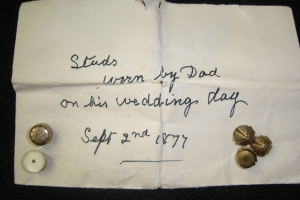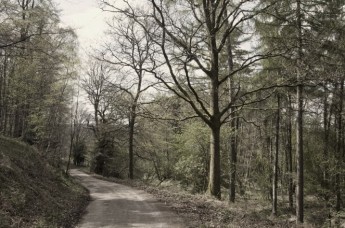 Richard Yemm was born on June 13, 1853, in the Forest of Dean in Gloucestershire, England. He was the fifth of seven children born to Stephen Yemm and Ann Harper. His family lived in the village of Upper Lydbook, in an area called Worrall Hill, where Stephen and Ann had moved shortly after the birth of their first child.
Richard Yemm was born on June 13, 1853, in the Forest of Dean in Gloucestershire, England. He was the fifth of seven children born to Stephen Yemm and Ann Harper. His family lived in the village of Upper Lydbook, in an area called Worrall Hill, where Stephen and Ann had moved shortly after the birth of their first child.

An entry in the English Bicknor church book: “Alice the daughter of John Yeme was baptised the vith [sixth] daio of August in the yere afforesaied [1571].”
The Yemm surname and variants Yem and Yeme are found in parish records in the Forest of Dean as far back as the 1500s!
xxxxxxxxxxxxxxxxxxxxxxxxxxxxx
Richard was baptised at the Lydbrook Church in Upper Lydbrook, which opened in 1852 and is still active today.

Lydbrook Church, c. early 1900s. Gone now are the charming covered gate and stately trees gracing the church yard. As with many old graveyards, time and nature have taken a toll on the old stones, with many tilting precariously, toppled, or sunk into the ground and overgrown. Photo reproduced with permission of Forest Prints, http://www.forestprints.co.uk/.
The 1861 England Census shows Richard with his parents and five siblings (his oldest sister had married and moved out by that time). Among the Yemms’ neighbors on Worrall Hill were Stephen’s parents, as well as two of Ann’s brothers and their families. Seven-year-old Richard, a student (or “scholar” in census terms) had no less than eleven first cousins living just a few doors away.
Ten years later, when the 1871 England Census was enumerated, Yemms and Harpers still proliferated on Worrall Hill. Another of Richard’s sisters had married and moved out, but Richard’s nephew, three-year-old Hubert Lugg, was noted as a visitor-in-residence. I imagine Worrall Hill was a vibrant and close-knit community.
Richard, who was 17 years old in 1871, was reported to be working as a collier—a coal miner—following in the footsteps of his father and his father’s father. On December 30 in 1874, the year in which Richard turned 21, he registered as a Freeminer. Freeminer is an ancient title given to coal or iron miners in the Forest of Dean who have earned the right, by law, to mine personal plots known as gales. The term and concept are unique to the Forest of Dean. According to the Dean Forest (Mines) Act of 1838:
“All male persons born or hereafter to be born and abiding within the said Hundred of St Briavels, of the age of twenty one years and upwards, who shall have worked a year and a day in a coal or iron mine within the said Hundred of St Briavels, shall be deemed and taken to be Free Miners.”
On September 2, 1877, Richard married Esther Cooper at the Lydbrook parish chapel. Witnessses to the wedding were siblings of the bride and groom: Joseph Harper and Sarah Yemm. The newlyweds began their married life in the hamlet of Carterspiece, less than a mile away, as the crow flies, from Worrall Hill. In January 1879, Richard and Esther welcomed their first child, my great-grandmother Esther. Over the next ten years, they would have five more children: Joe in 1881, Stephen in 1883, Florence Mary in 1886, George Alec in 1888, and finally, Ada Blanche (Dollie) in 1890. All six children were baptised at the parish chapel at English Bicknor. Between the time George and Dollie were born, the family moved to a cottage at Birchmarsh, just down the road from Carterspiece. The Yemm family, now numbering eight, were living at Birchmarsh when the 1891 census was enumerated. The four older children attended school, probably at English Bicknor.
The ensuing decade brought many changes to the Yemm family. At that time in the Forest of Dean, custom and economic necessity dictated that young girls went into domestic service and young boys followed their fathers into the mines. And so it was that Esther was sent off to Gloucester to work as a scullery maid, and Steve and Joe began working in the coal mines. All were still minors. Sadly, the family lost little George in 1894 at age six, when he succumbed to “epilepsy, dehydration, and chronic diarrhea.” In 1897 Richard moved his family to a cottage located at the Trafalgar Colliery, where he and his sons worked. Since the main mode of transportation was by foot, it would have been a boon to live so close to the mine. There were only a handful of cottages at the Colliery, and most appear to have been occupied by mine managers and the like. I suspect Richard must have had an inside connection to secure that housing arrangement.

Richard was born and died at Worrall Hill, and never lived farther than two miles away from that beautiful spot in the Forest of Dean. Many Yemms, including Richard’s father, came from Ruardean, which lies just to the northeast of Ruardean Woodside.
By the 1901 census, the Yemm family (absent Esther, who was still working out of the home as a domestic) had been joined by little Godfrey Cooper, age 1. Godfrey was the son of the elder Esther’s brother James, whose wife, Emma, had died in childbirth. The older Cooper children stayed with their father, but the younger children all went to live with various relatives. The Yemms couldn’t have been happier to have Godfrey join their household; no doubt he helped fill a hole that was left when Georgie died. My great-grandmother Esther and her sister Florence often commented on how much the family loved little Godfrey. By 1906, Richard’s three oldest children were off to America, Esther to join her sweetheart from the Forest of Dean, Joe and Steve, for better economic opportunities. Around that same time Richard moved his family for the last time, back to his beloved Worrall Hill.
In the 1911 census, the Yemm household numbered just three: Richard, Esther, and Godfrey. Florence had moved to London to begin nursing studies at The London Hospital. Dollie worked as a servant and nanny for a surgeon who lived in Carmarthenshire, Wales. Richard was still working in the mines as a coal hewer, nearly forty years by this time, and now, finally, owned his own home. He must have been pleased to learn that his sons had both left the coal mines and joined the Christian ministry. I imagine he felt some sadness, too, missing his children and not knowing his grandchildren (by now there were two, Esther’s daughter Ruby and Joe’s son Dean).
The next several years were tumultuous, on scales both personal and global. Just as Florence finished up her nursing program in 1914, World War I began. Surely Richard felt a mix of patriotism, pride, and worry when his daughter signed up with Queen Alexandra’s Imperial Military Nursing Service to aid the war effort. On the home front, there was dissent in the miner’s union as the British government sought to use the union to pursue its war aims. I wonder how that conflict impacted Richard? In 1916, Richard bid daughter Dollie farewell as she sailed to America for an extended visit with her brothers and sister. During her visit, Dollie fell in love and married; she never returned to England. Godfrey married in 1917 and left home as well. Richard would only know of his children’s trials and tribulations from afar. By the end of the war, seven grandchildren had been born, one lost, and daughter Esther was a widow. Many losses nearer to home—those suffered by family, friends and neighbors during the Great War—would have weighed heavily as well.
Florence returned safely home to Worrall Hill in 1919, which must have been a tremendous relief and blessing for Richard and Esther. In 1920, son Steve returned to England for an extended stay after losing his wife and unborn child to influenza. His visit was no doubt as much a comfort to his parents as to himself. Steve was still home when Richard died on April 27, 1921. Richard was buried in the English Bicknor churchyard, where little George had been laid to rest nearly 30 years earlier.
Richard lived all of his 67 years within a two-mile radius in the Forest of Dean, where his roots ran as deep as those of the mighty oaks that grow there. From bits and pieces of family lore, I gather that Richard had a serious, and perhaps even stern, demeanor. He grew up in a community where hard work was the norm, and where family relationships were strong and supportive—values he apparently carried throughout his life. For all I don’t know about Richard, I do know that he was a stable and consistent presence for his family, held in high regard by his loved ones. His influence on his children is evident: they grew up to be good, solid citizens who worked hard and added “something of worth to this needy old earth.” An anchor, indeed.
Rest in peace, Grandfather Yemm.







What a great piece of history. He is probably where I get my deep roots to the ol’ homestead in the Vale of Hanna.
LikeLike
Hi Andy, thanks for your comment. Yes, I think that you and Grandfather Richard shared a love for home, and that’s a lovely thing! XO
LikeLike
What a wonderful opportunity you have given us to capture the essence of our ancestors. They are no longer a photo or an abstract reminiscence. They are now people to us both personally and geographically. I suspect not many people have the ability to intuit their lives in such a compelling way and aside from the hard facts you provide, everything else rings true! The link to our past is much stronger and a lovely addition to our lives. Thank you honey.
ACXO
LikeLike
Thank you so much, Auntie. This whole process is so enjoyable for me, and as I work on each piece, each ancestor becomes more real to me, too. I truly love that. XO
LikeLike
What an interesting story of Great Grandfather Richard. It really makes our trip to England much more meaningful, especially in The Forest of Dean. What a magical place! I loved visiting the grave sites of our relatives and this really brings out his story. Thank you for such a lovely memoir. Love, Mom
LikeLike
Thanks Mom! It was kind of amazing to be in the Lydbrook Churchyard and think that Richard was baptized there, and married there, too. So glad we got to visit Richard’s beloved Forest of Dean! XO
LikeLike